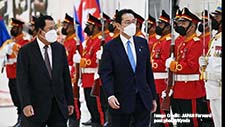Clashes, Crises and Confusion: Japanese Politics at a Crossroads
Bert Edström
The general election in Japan on August 30 resulted in a new coalition government formed by three former opposition parties. Focusing both on the short-term task of compil¬ing the national budget, and on the long-term task of reforming the political decision-making system, Prime Minister Hatoyama Yukio was soon to realize that his party’s ambitions to institute “real reforms” was an evasive goal. The rigidities and restrictions the new government is encountering are formidable and the prospects of success are unsure, notwithstanding that the mandate handed to the new government is strong.
Related Publications
-
Post-Abe India-Japan Ties: Does Kishida Have What it Takes?
Introduction: Two Japan-India summit meetings between prime ministers Kishida Fumio and Narendra Modi in 2022 underscore their accelerating Special Strategic and Global Partnership. This partnership is based on the shared values of freedom, […]
-
Kishida in Cambodia: Seeking Regional Consensus Amid the China Threat?
Last of a two part series on Prime Minister Fumio Kishida’s travel to India and Cambodia in March 2022. This article is part of the [Asia’s Next Page] series on JAPAN […]
-
North Korean Nationalism: Reading the Paleolithic Text
North Korea, after over seven decades since establishment, continues to be poorly understood. The paucity of knowledge regarding the country is not only a matter of the lack of access […]
-
Xi Jinping Thought: Xi’s Struggle Against Political Decline
Abstract One of the latest extensions of Xi Jinping’s influence on Chinese society is the incorporation of ‘Xi Thought’ into elementary and middle school curriculums. Like his predecessors, Xi is […]



